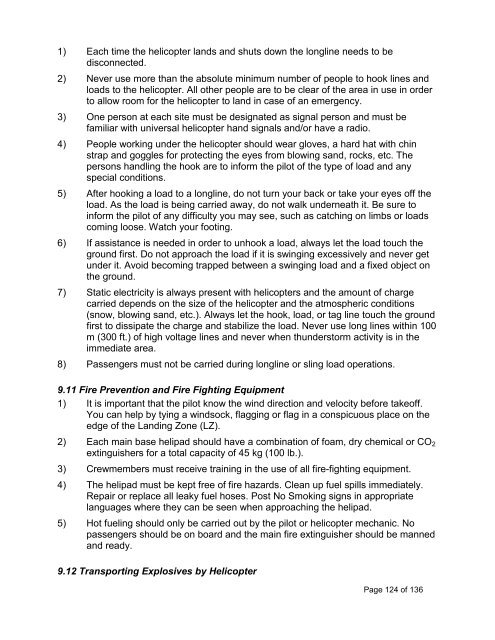IAGC LAND GEOPHYSICAL SAFETY MANUAL Edition 9 ... - CGISS
IAGC LAND GEOPHYSICAL SAFETY MANUAL Edition 9 ... - CGISS
IAGC LAND GEOPHYSICAL SAFETY MANUAL Edition 9 ... - CGISS
- No tags were found...
Create successful ePaper yourself
Turn your PDF publications into a flip-book with our unique Google optimized e-Paper software.
1) Each time the helicopter lands and shuts down the longline needs to bedisconnected.2) Never use more than the absolute minimum number of people to hook lines andloads to the helicopter. All other people are to be clear of the area in use in orderto allow room for the helicopter to land in case of an emergency.3) One person at each site must be designated as signal person and must befamiliar with universal helicopter hand signals and/or have a radio.4) People working under the helicopter should wear gloves, a hard hat with chinstrap and goggles for protecting the eyes from blowing sand, rocks, etc. Thepersons handling the hook are to inform the pilot of the type of load and anyspecial conditions.5) After hooking a load to a longline, do not turn your back or take your eyes off theload. As the load is being carried away, do not walk underneath it. Be sure toinform the pilot of any difficulty you may see, such as catching on limbs or loadscoming loose. Watch your footing.6) If assistance is needed in order to unhook a load, always let the load touch theground first. Do not approach the load if it is swinging excessively and never getunder it. Avoid becoming trapped between a swinging load and a fixed object onthe ground.7) Static electricity is always present with helicopters and the amount of chargecarried depends on the size of the helicopter and the atmospheric conditions(snow, blowing sand, etc.). Always let the hook, load, or tag line touch the groundfirst to dissipate the charge and stabilize the load. Never use long lines within 100m (300 ft.) of high voltage lines and never when thunderstorm activity is in theimmediate area.8) Passengers must not be carried during longline or sling load operations.9.11 Fire Prevention and Fire Fighting Equipment1) It is important that the pilot know the wind direction and velocity before takeoff.You can help by tying a windsock, flagging or flag in a conspicuous place on theedge of the Landing Zone (LZ).2) Each main base helipad should have a combination of foam, dry chemical or CO 2extinguishers for a total capacity of 45 kg (100 lb.).3) Crewmembers must receive training in the use of all fire-fighting equipment.4) The helipad must be kept free of fire hazards. Clean up fuel spills immediately.Repair or replace all leaky fuel hoses. Post No Smoking signs in appropriatelanguages where they can be seen when approaching the helipad.5) Hot fueling should only be carried out by the pilot or helicopter mechanic. Nopassengers should be on board and the main fire extinguisher should be mannedand ready.9.12 Transporting Explosives by HelicopterPage 124 of 136
















